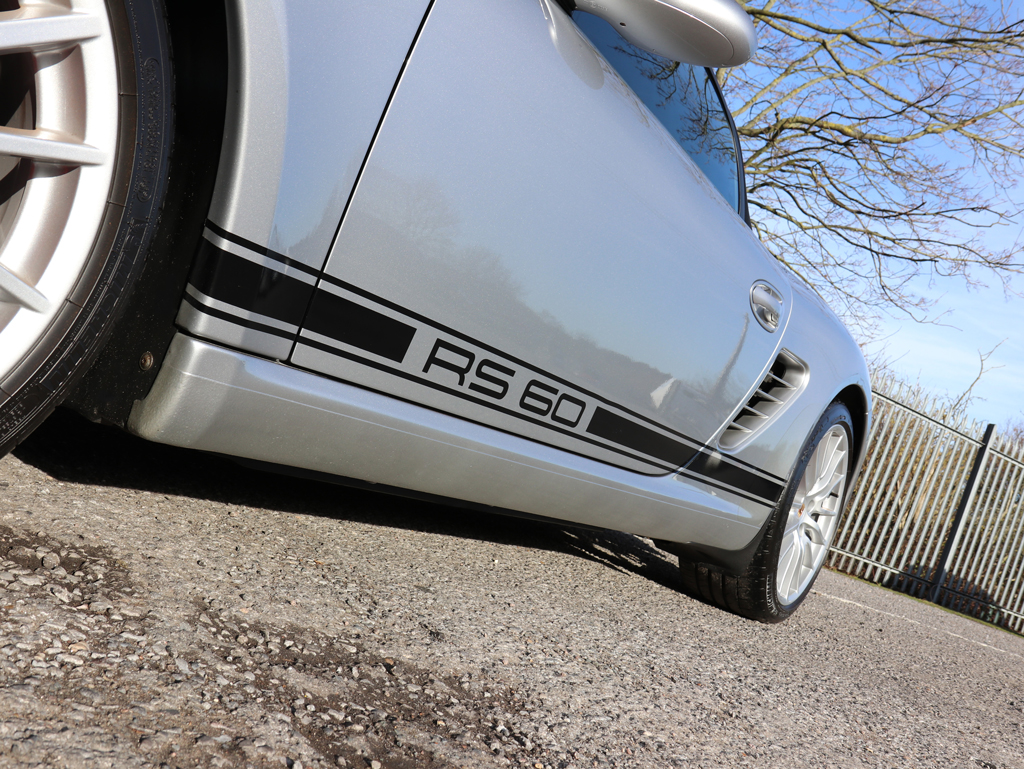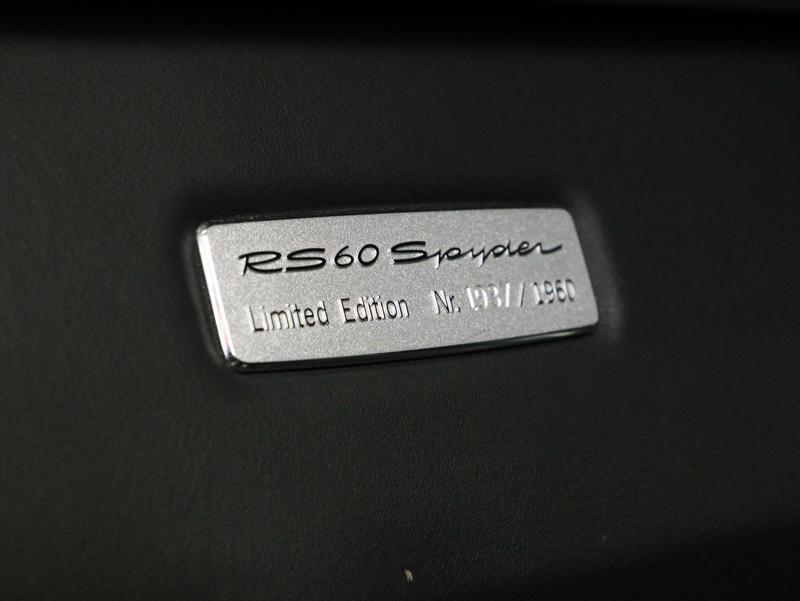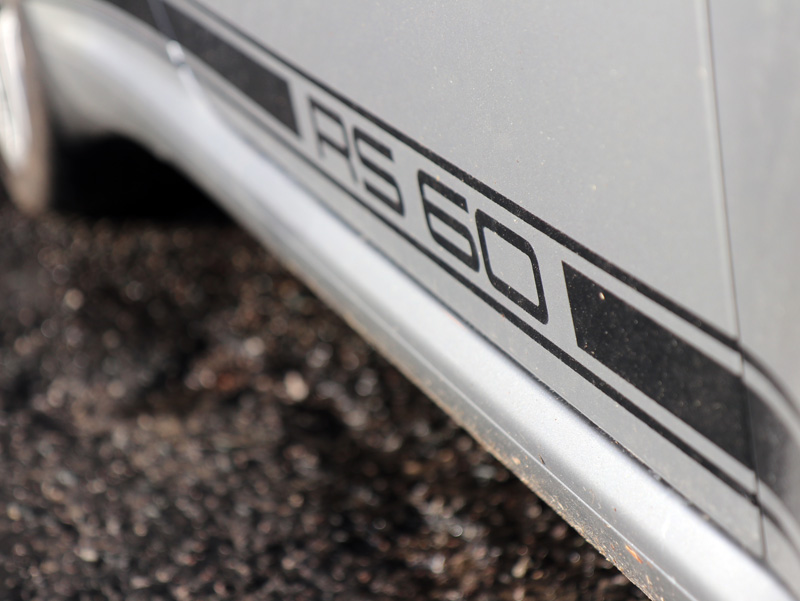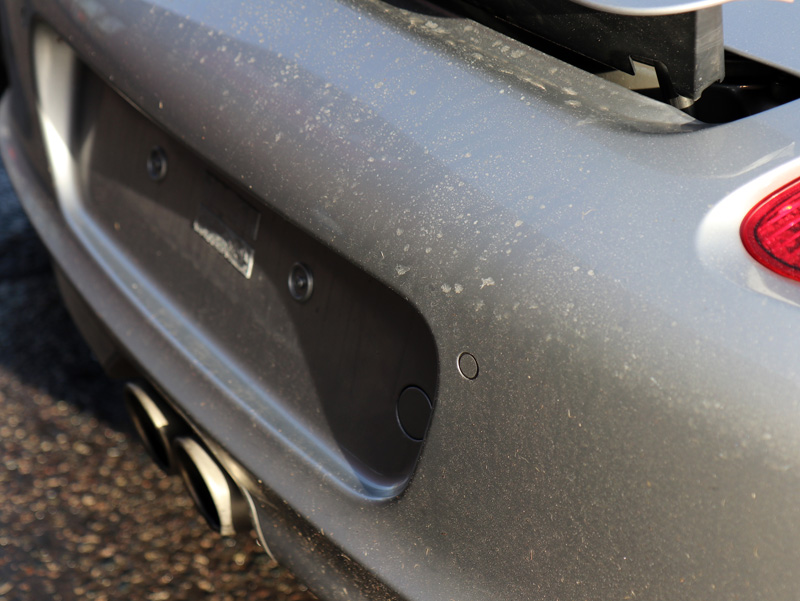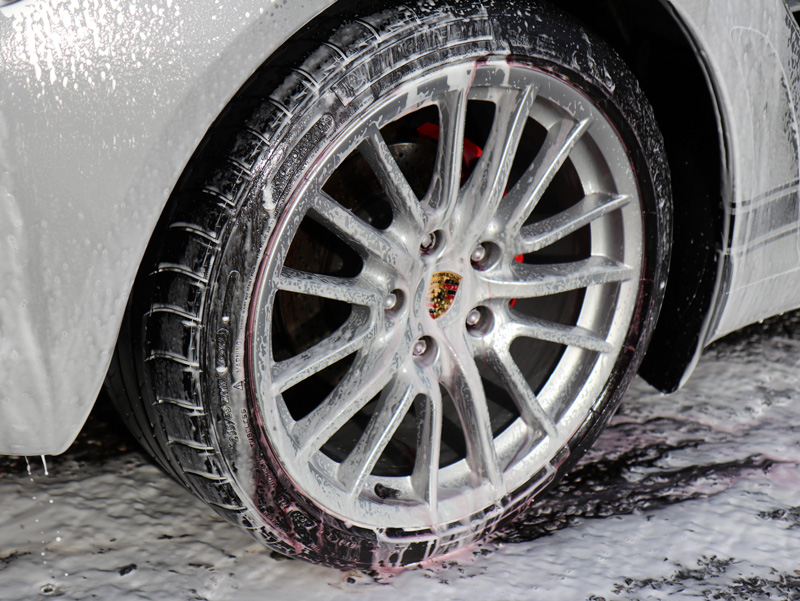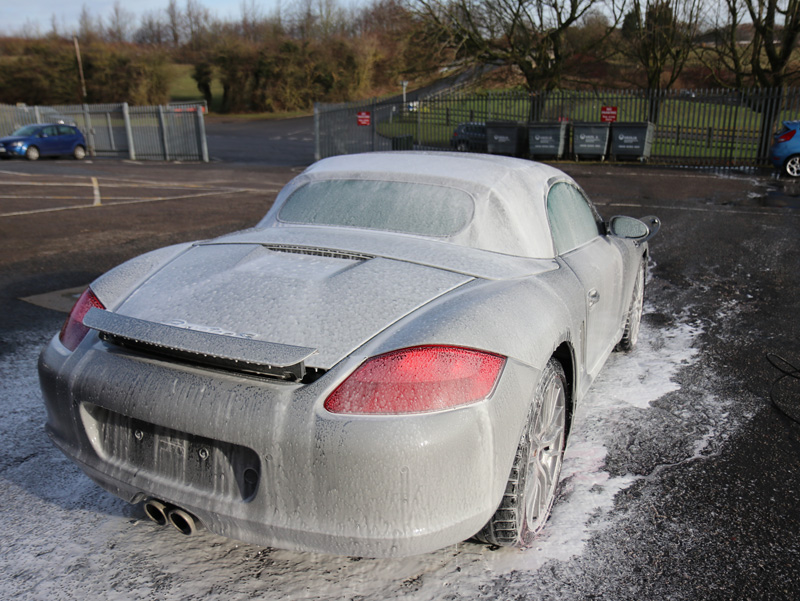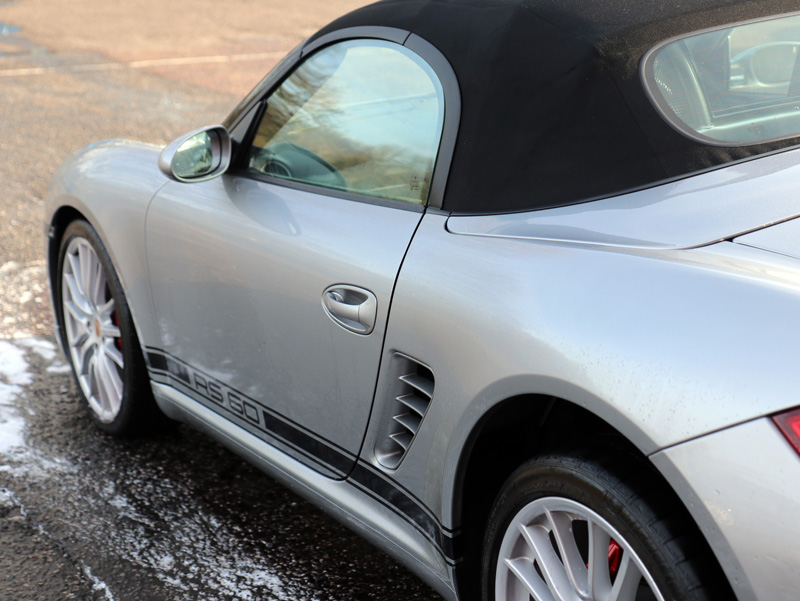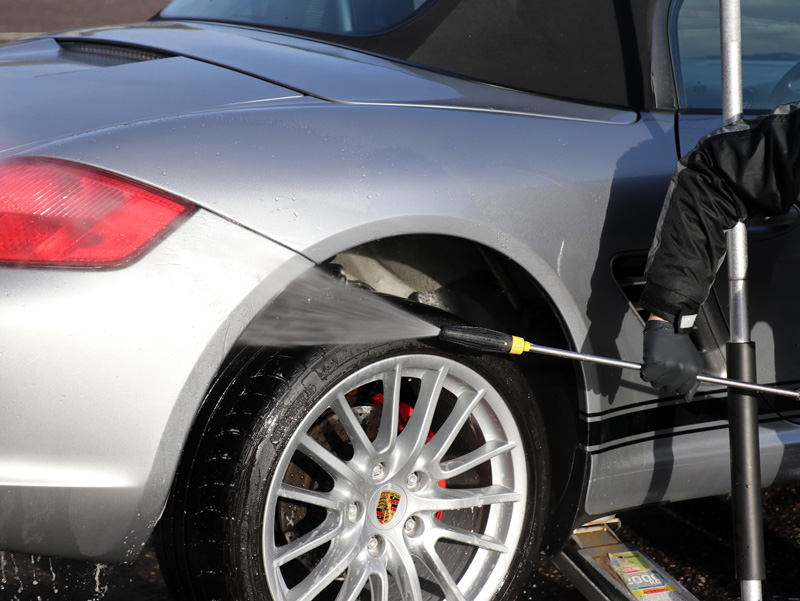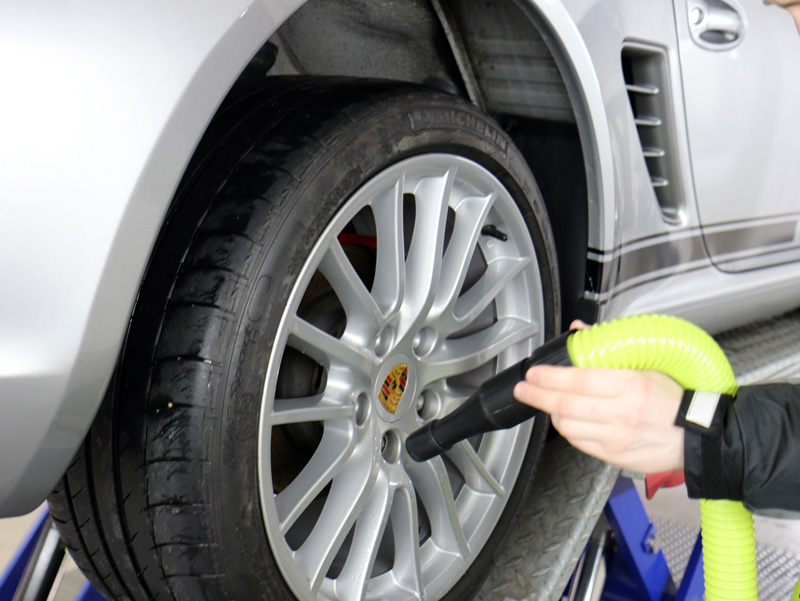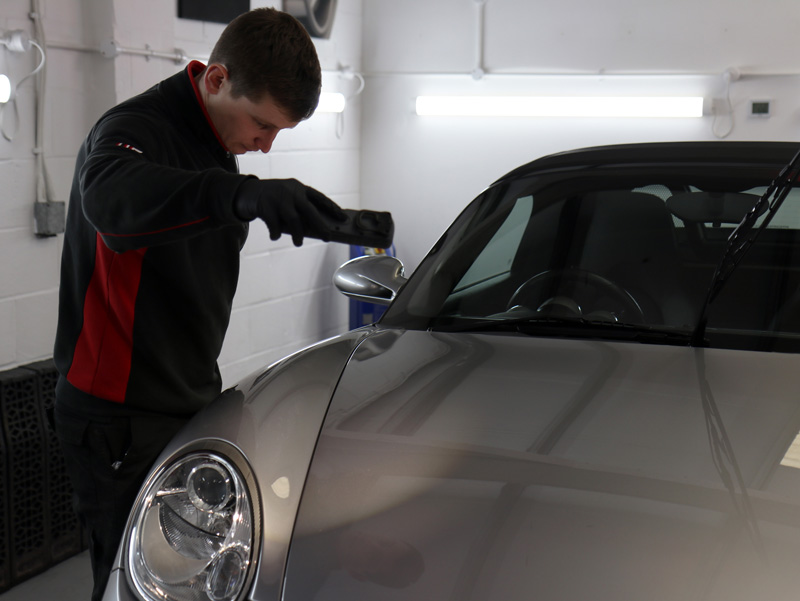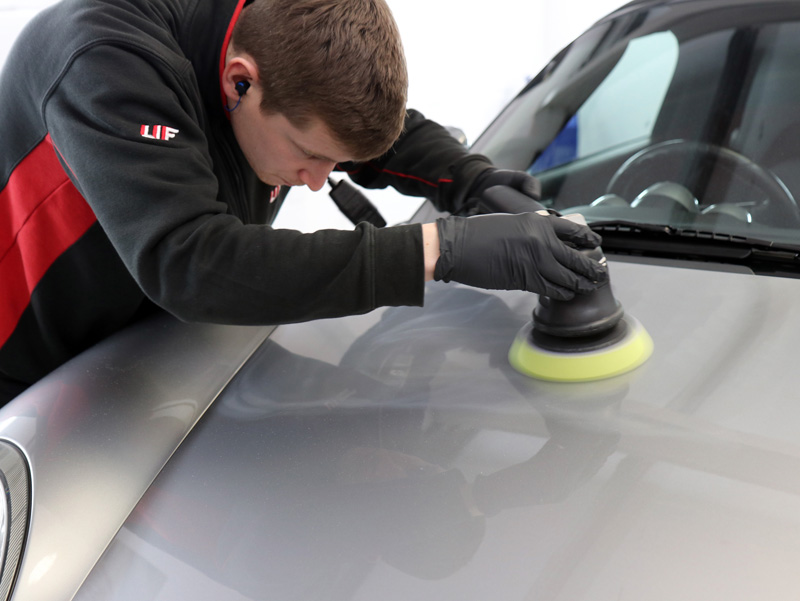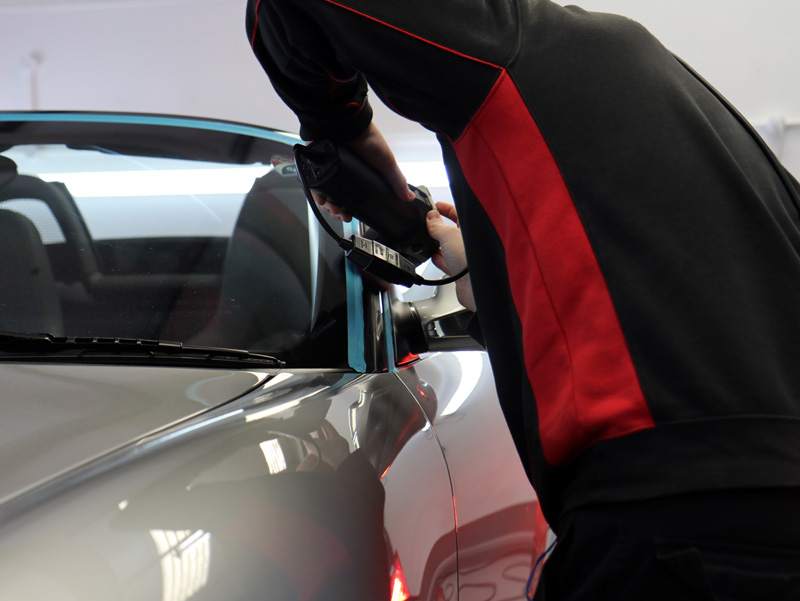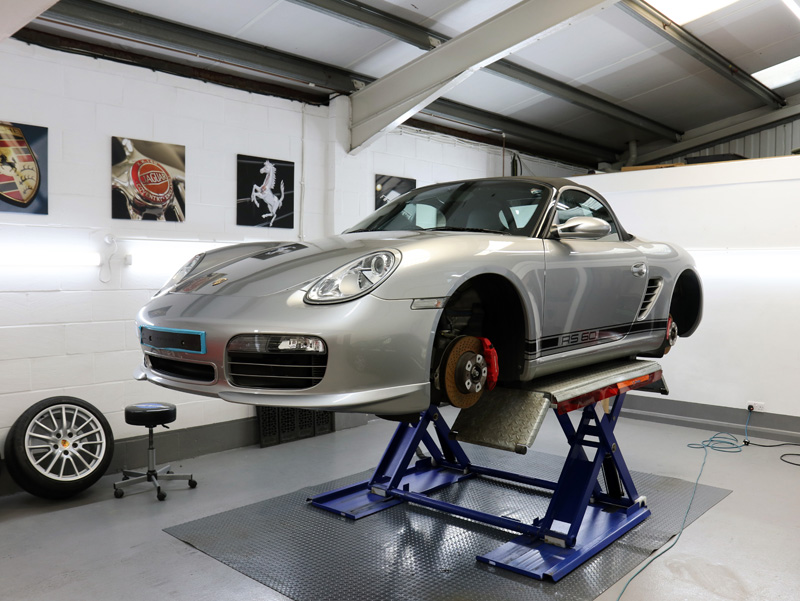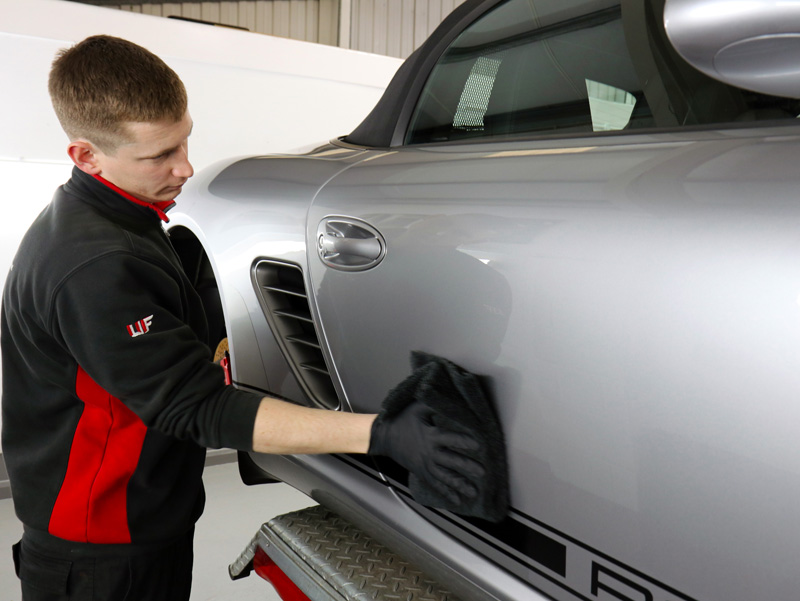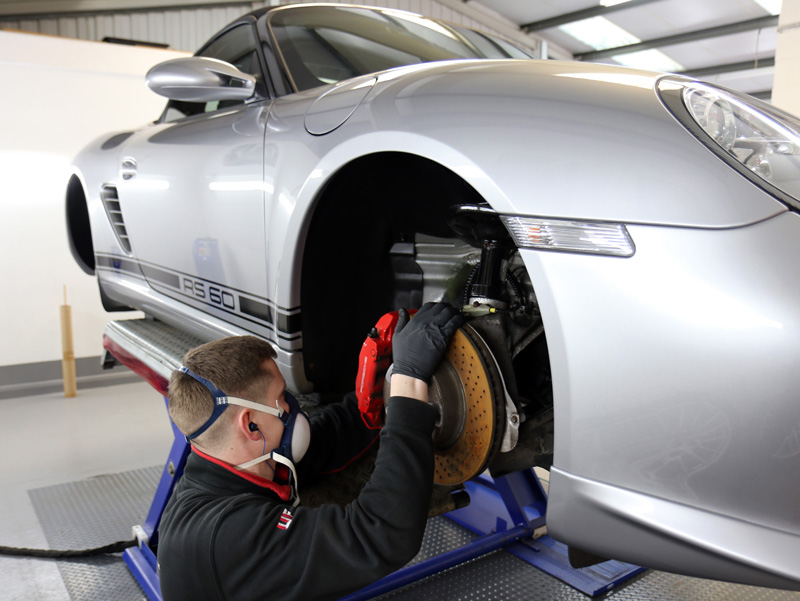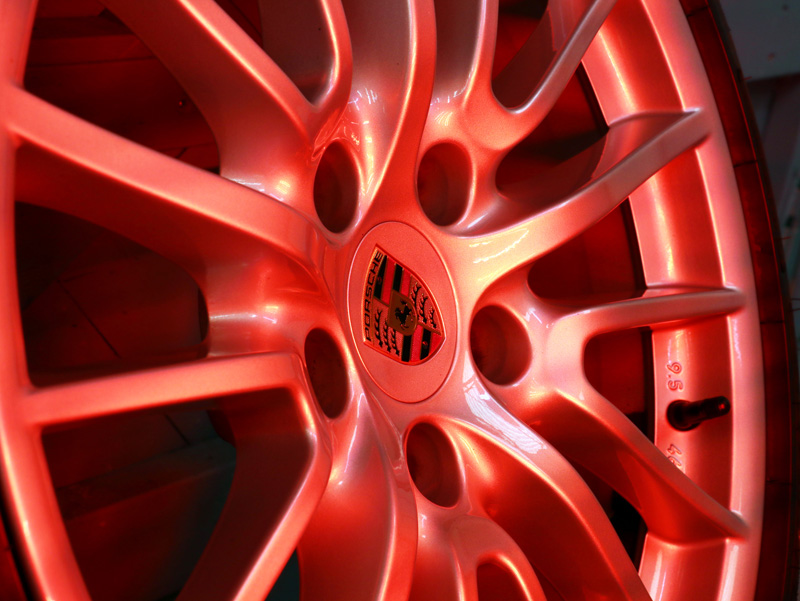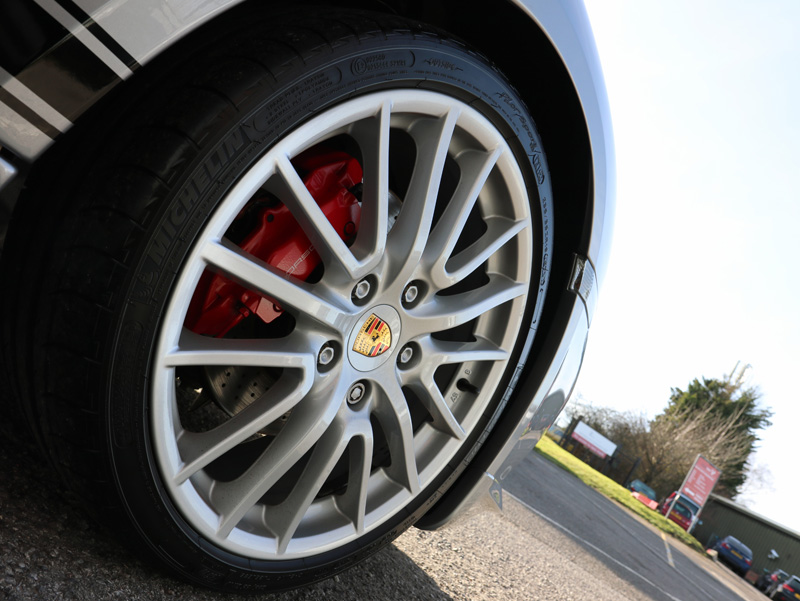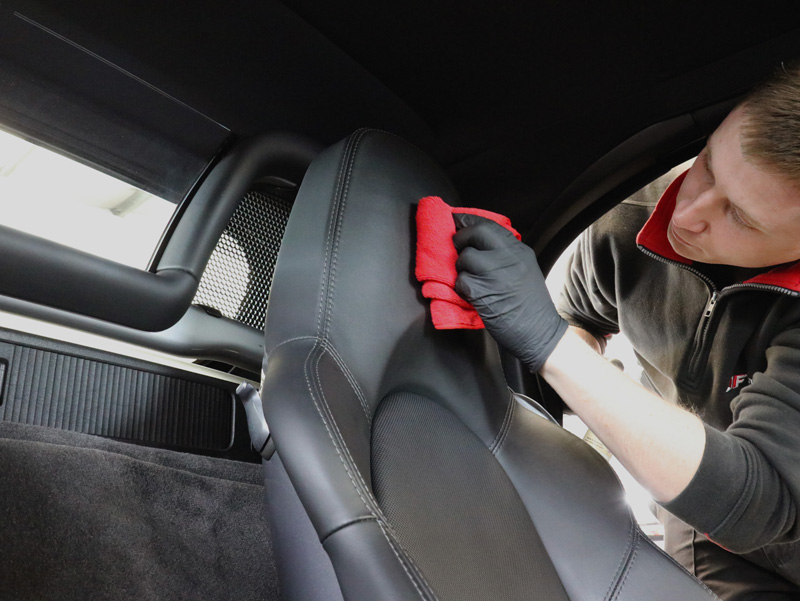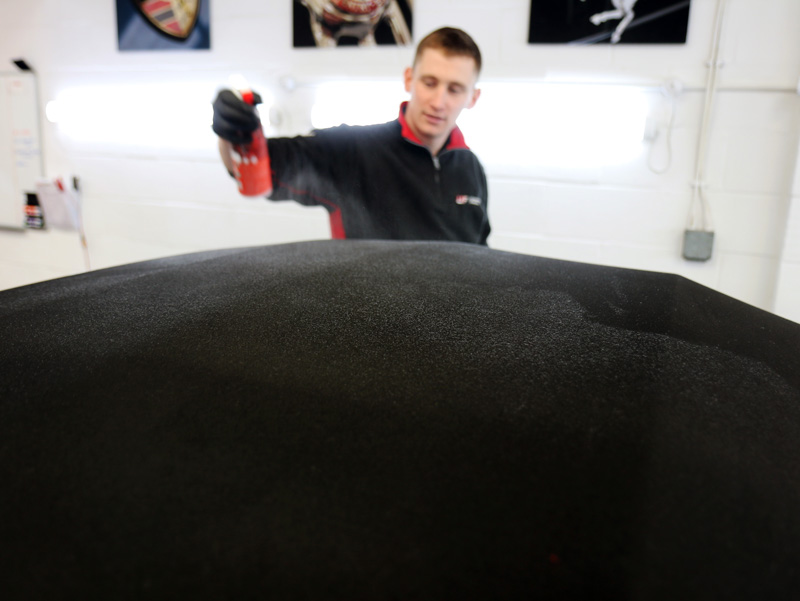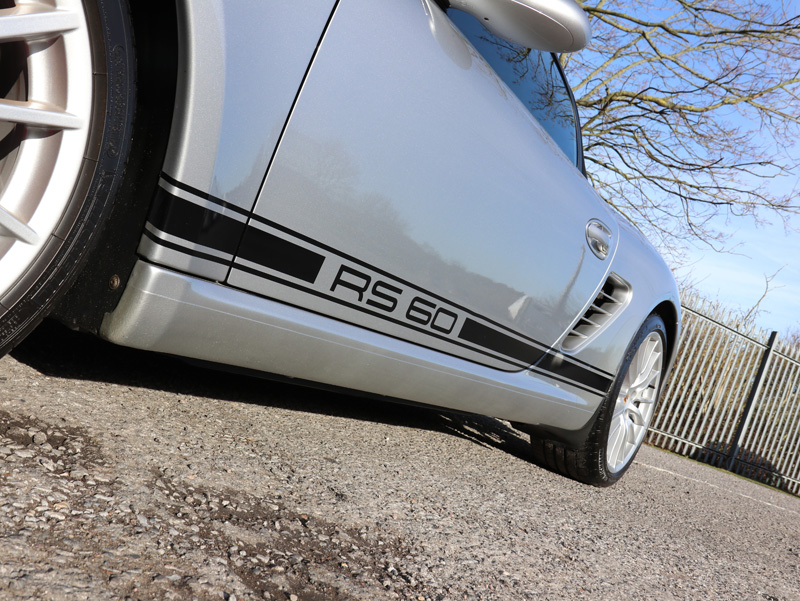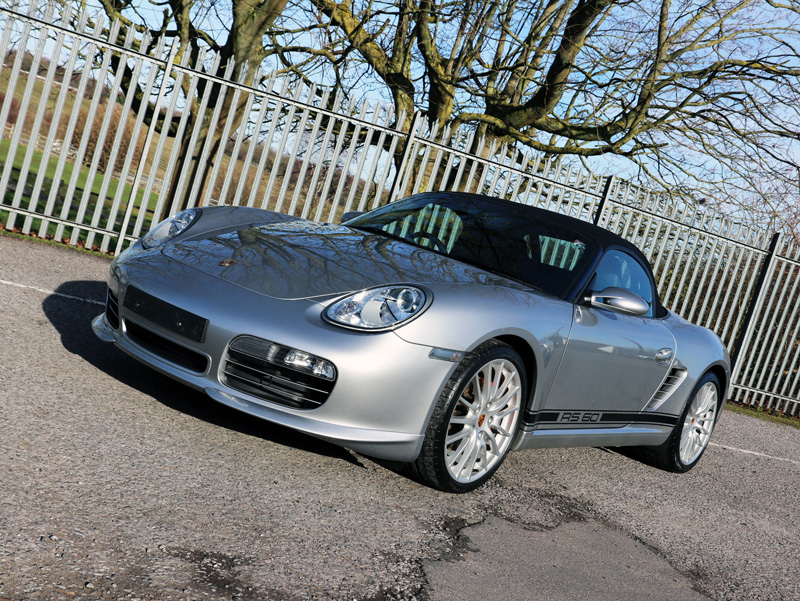Porsche Boxster RS 60 Spyder – Restoring A Future Classic
In 1960, a silver Porsche Type 718 RS 60 Spyder won its first overall victory in the 12 Hours of Sebring race. A surprise victory for the 718, thought to be out-powered and outclassed by the competition, the result gave rise to Porsche’s reputation as a ‘Giant Killer’. It is just this type of win that has given Porsche the legendary status it enjoys around the world to this day.
The 2008 Boxster RS 60 Spyder was built in honour of this victory. The similarities in design are unmistakable, the stance and styling immediately evocative of the Type 718. Still a mid-engine, two-seater sports car, the Limited Edition is immediately distinguishable from the standard Boxster S by the more aggressive stance and a front end taken from the ‘SportDesign’ Package. The ‘SportDesign’ alloy wheels are more prominent thanks to added spacers, giving the RS 60 a more aggressive and road-hungry presence. A black windscreen frame, red taillight covers further mark this car apart from the crowd. In true modern Porsche style, the RS 60 benefits from Porsche Active Suspension Management (PASM) which comes as standard, so whether the driver is looking to enjoy a comfortable motorway cruise or wants to make the most of interesting roads, the RS 60 accommodates.
But it’s not only the exterior that benefits from the racing pedigree; the interior has some nice touches too. Stainless steel door guards announce the model designation as you enter the vehicle. The GT Silver Metallic instrument cluster is wider set and stands prominently on the dash, in true race car style, without their usual cover, and the gearshift lever is also race-inspired. The centre console has been finished in GT Silver Metallic, as are the seat backs, roll bars and seat belts.
Available only in GT metallic silver, the RS 60 was available with a Carrera Red natural leather interior and matching soft-top, or a Dark Grey interior with a black hood. To honour the momentous year for this car, only 1960 of these limited edition models were made, worldwide. Number 1937 of 1960 arrived at UF’s Brands Hatch detailing studio recently for a number of cosmetic services including Gloss Enhancement Treatment, Alloy Wheel Protection, Leather Protection and Convertible Roof Protection.
The RS 60 Spyder arrived with us having recently been acquired by its new owner who wanted to restore the paintwork to the condition the car deserved. As he planned to enjoy the car with the roof down (weather permitting!) he requested the leather be cleaned and protected. The interiors of convertibles are susceptible to increased wear and tear. The exposure to UV weakens the fibres of the material making it more prone to rips and tears as well as fading – especially with dark material. Exposure to air in a convertible also results in the accumulation of a fair amount of dust and dirt. – Matt Back, UF Detailing Studio
First, the registration plates were removed to allow for comprehensive cleaning behind these areas that easily trap dirt.
Then, to prepare the soft top for cleaning, the hood was brushed using a soft bristled brush to remove any loose dirt from the fibres. The hood was dampened and Renovo Soft Top Canvas Cleaner was applied using a sponge, beginning in the centre and working towards the edges. The solution was allowed to dwell while attention turned to the bodywork and wheels. A trolley jack was used to raise each corner of the car in turn to increase the space between the wheel and the arch. These areas were treated first with Bilt-Hamber Surfex HD to remove greasy deposits and general debris. Then, Gtechniq W7 Tar & Glue Remover was sprayed on to tackle the significant build-up of tar and rubber.
Although the Boxster had clearly been ‘loved’, the previous owner may not have been aware of the different types of contamination that can accumulate and without the right cleaning products, are difficult to remove. Consequently, there were sticky black drops all over the wheel arches, along the sills, over the alloy wheels and up the side and rear panels which had become bonded to the surface. W7 breaks down these sticky bonds, literally melting the contamination making it easier to remove. – Matt Back, UF Detailing Studio
Bilt-Hamber Korrosol was sprayed onto the wheels and bodywork to tackle ferrous contamination. This type of particle is derived from pads shredding when the brakes are applied, so the highest concentration of this type of contamination is usually found on the wheels and lower sills. The hot particles bond to surfaces and can cause pitting if left in place. Korrosol changes colour in the presence of iron and, with Ultimate Snow Foam applied to the wheel, the deep purple was immediately highlighted.
Ultimate Snow Foam is designed to remove remaining lose dirt from bodywork and wheels, so after allowing the solution to dwell for a few minutes, the bodywork and Renovo Soft Top Canvas Cleaner on the hood were then rinsed thoroughly, ensuring every trace of the cleaning solution was removed from the hood’s fibres and from every nook and cranny.
Leaving suds in the hood stores up problems for later: the suds act as a wick for water ingress and also act as a focal point for mildew – even when a fabric sealant has been applied. Additionally, the waterproofer will seal the hood and you don’t want to seal what will effectively be contamination beneath it. ~ Matt Back, UF Detailing Studio
The RS 60 was washed using the Two Bucket Method: one bucket containing wash water, the other, plain water. Both buckets have Grit Guards. The wash mitt is loaded with wash solution and a section of the bodywork cleaned. The mitt is then rinsed in the Rinse Bucket and brushed across the Grit Guard, releasing dirt from the pile. The mitt is wrung out before being dunked back in the soapy wash water. In this manner, dirt removed from the panels is prevented from being reintroduced, making the wash process far safer for the clear coat. The suds were rinsed away before an Aqua Gleam De-ionising Water Filter was attached in-line with a hose to deliver a final pure water rinse. The RS 60 was brought into the detailing studio where it was raised onto a hydraulic ramp and dried using a BigBoi BlowR Pro. This touchless car drying system uses warm filtered air to chase water off the panels and out from behind badges, grilles, mirror housings, and other tight areas which naturally trap droplets. This prevents the water from escaping later and streaking down the paintwork causing unsightly marks and potentially interfering with the curing process of the coating. The powerful jet of air is particularly effective at drying hard to reach areas such as around wheel nuts and calipers.
Once dry, the wheels were removed for protecting separately and the BlowR Pro was used again to check the callipers and wheel arches were completely dry. The paintwork was then comprehensively inspected for damage under high-intensity lighting.
The finish was quite clearly covered in wash swirls and also had a few random deep scratches (RDS), the position of which were noted on the Vehicle Appraisal Sheet for reference during the gloss enhancement stage. Multiple paint depth readings were taken over each panel to determine the thickness of the paint and to check for uniformity of coverage. Sensitive areas such as black trim and door rubbers were then protected from polish contamination with 3M detailing tape. Then, using a RUPES LHR 12E Duetto dual action polisher with a RUPES Yellow Fine Polishing Pad and Menzerna Medium Cut Polish 2200, the silver metallic paintwork was restored.
In areas where the deeper scratches were challenging, a Kamikaze Collection Banzai Dynamics 75mm Polishing Pad was used with a RUPES LHR 75E Mini dual action polisher. The smaller head of this machine works with the shorter than standard throw to produce a more concentrated polishing action and is also useful for polishing along narrow areas such as door pillars or mirror covers. The Banzai Dynamics Red Polishing Pad uses Dot Point Polishing (DPP) technology to increase the surface cutting area of the pad which encouraging air flow for longer working times, avoiding the issue of incurring micro marring as a result of excess heat generation. For the narrow areas where the paintwork was not as marked, a RUPES 4-inch Fine Polishing Pad was used with the BigFoot Mini.
With Porsche paintwork being reasonably hard, I opted for a medium grade pad and compound combination. If you start out with a really aggressive combination, you run the risk of putting additional marks into the paintwork and then having to remove more of it to restore the clarity. The combination of Menzerna, experienced in the challenges associated with scratch resistant German paintwork and the RUPES polishing pad, which has a hole in the centre to distribute air flow more effectively allowing for longer working times, worked perfectly. ~ Matt Back, UF Detailing Studio
The paintwork was then refined with Menzerna Super Finish Plus 3800 and a Kamikaze Collection Banzai Dynamics Black Finishing Pad, the fine jewelling polish perfectly complimenting the soft pad to produce a reflective and extremely glossy shine.
The bodywork was sprayed with Gtechniq Panel Wipe to remove polish residues before Kamikaze Collection ENREI was applied. ENREI is Kamikaze Collection’s flagship, 2-stage ceramic system.
Kamikaze Collection ENREI consists of two separate layers: No.1 Base Primer Coat and No.2 Top Coat. Base Primer Coat has been engineered to have a high chemical affinity with both the car’s clear coat and with the No.2 Top Coat, bonding the two together providing a long-lasting protection barrier against dirt and contamination build-up whilst delivering a seriously impressive shine. The key to ENREI’s performance lies not only in the formulation but also in the method of application which has been researched and developed by Kamikaze Collection International. To get the most from this coating, the method has to be followed precisely so detailers undergo training. Once trained, they have exclusive access to ENREI and as a result this service is only available through the Kamikaze Collection UK Detailer network. – Matt Back, UF Detailing Studio
With the wheels removed, remaining tar and rubber deposits were easy to see and also to access. Another application of W7 Tar & Glue Remover was made, ensuring all deposits were removed from the wheel arch, brake lines and visible suspension components.
The wheel arch linings were protected with Gtechniq T1 Tyre & Trim to provide a barrier against further build-up. The other components were protected with Autoglym Silicone-Free Spray to prevent adhesives from sticking to them. Then, the wheels and calipers were treated with Panel Wipe before being protected using Kamikaze Collection Stance Rim Coat, a hydrophobic, oleophobic and heat resistant nano-coating. Stance Rim Coat repels water and the dirt carried by it, oils and even brake dust and tar. Contamination does not adhere to treated surfaces making them easier to maintain and negating the requirement for using astringent wash chemicals. This helps prevent dulling and damage caused by environmental and industrial fallout as well as protecting rims from the substances used to keep roads free from ice during cold weather. Once the wheels had been coated, they were placed in front of infrared lamps to accelerate the curing process. Once the coating had fully cured, the wheels were replaced.
To complete the look of the wheels, the tyres were given a layer of Gtechniq T2 Tyre Dressing to provide a long-lasting natural satin sheen.
The leather interior was cleaned using Colourlock Mild Leather Cleaner. The light foam is sprayed onto a sponge or brush and worked into the leather grain, lifting out trapped dirt. The area is then wiped with a soft clean microfibre. Once dry, the area is protected using Colourlock Leather Shield, providing a dust repelling, water-repelling surface that helps prevent stains from accidental spills and muddy footwear. The satin matte finish leaves leather protected from abrasion and from the damaging, drying and fading effects of UV.
The bodywork was covered with protective detailing film and the hood was protected by spraying liberal amounts of Gtechniq I1 AB Smart Fabric Coat over the area. This sealant coats the individual fibres, preserving the texture of the hood whilst providing a comprehensive barrier against rainwater, industrial and environmental contamination. I1 helps prevent fading caused by UV and the antibacterial (AB) function, inhibits the formation and development of mildew.
With the extensive cosmetic work now completed, the Porsche Boxster RS 60 Spyder looked absolutely stunning and given the level of protection, was sure to stay that way for many years to come.
UF Detailing Studio – Award Winning Detailing. Call 0333 800 8004 to discuss your requirements or complete the online enquiry form here to receive a bespoke no-obligation quotation by email.

